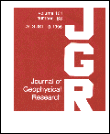
Collection and three-dimensional modeling of GPS and tilt data at Merapi volcano, Java
François Beauducel and François H. Cornet
Journal of Geophysical Research, Vol 104, No B1, Pages 725-736, January 10, 1999.
Abstract. We study here the deformations associated with the November 1996 to March 1997 eruption period at Mount Merapi (Central Java), one of the most active volcanoes in Indonesia. This activity period includes a vertical explosion on January 17 and an increase of the lava dome volume by about 3×106 m3. Two Global Positioning System (GPS) campaigns have been carried out on a six-benchmark network at the beginning and at the end of the period. Relative displacements with respect to the reference point show an average subsidence of 6.5 cm. A multicomponent tilt station installed on the southeast flank, 3 km from the summit, recorded a tilt of 11.1 ± 0.7 µrad in the tangential direction and 0.9 ± 0.4 µrad in the radial direction. These data are interpreted using a three-dimensional (3-D) elastic model based on the mixed boundary element method and a near-neighbor Monte Carlo inversion. Interpretation of tilt data requires an accurate mesh for discretizing the 3-D topography. The final result supports a horizontal elliptic magma source located 8.5 ± 0.4 km below the summit and 2 ± 0.4 km to the east of it. In particular, the data cannot be consistent with the location of a magma chamber determined from seismic activity analysis (i.e., 2 km below the summit). The computed depth depends strongly on the source shape and cannot be constrained properly because of the small amount of data. The computed deflation of 11 ± 2×106 m3 is about 3 times larger than the observed increase in the lava dome volume. This difference is attributed to rock avalanches and pyroclastic flows on the flanks of the volcano.